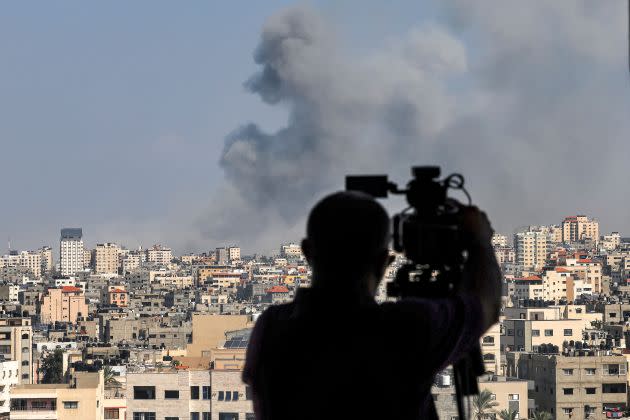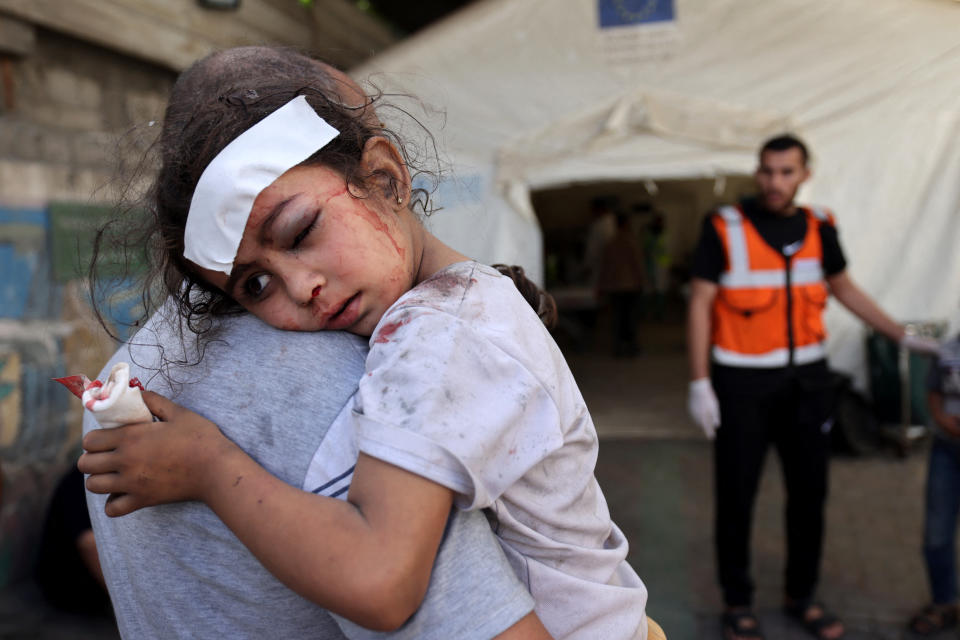Palestinian Journalists Navigate Blockade, Bombings & Evacuation To Keep News Flowing Out Of Gaza

International journalists have flocked to Israel in the wake of the heinous Hamas terror attacks on October 7, but none will be making it over the border to Gaza any time soon.
The world’s media is focused on a strip of land less than a third of the size of L.A., but the job of reporting on the plight of Palestinian civilians on the ground has largely fallen to local journalists. American and international news crews are not allowed into Gaza.
More from Deadline
Many are risking death to tell the story of a tragedy that has upended the lives of Gaza’s 2.1 million inhabitants. More than 2,700 locals have already been killed in the conflict.
Braced for an expected Israeli land invasion — retaliation for Hamas killing more than 1,400 Israeli civilians and taking another 199 hostage — is a local press corp. that comprises 1,200 professionals, who work for myriad Arabic-language and international outlets, according to the Palestinian Journalists Syndicate (PJS).
Experienced journalists such as Rushdi Abualouf for the BBC, Marwan Al-Ghoul for NBC, and Ibrahim Dahman for CNN have been joined by younger reporters such as Plestia Alaqad and Motaz Azaiza on social media in telling their reality first-hand.
Most of the footage running on the networks is being shot by Palestinian crews of AFP, AP, and Reuters news agencies, or lifted from UGC posts.
“Often when people go into to cover a conflict, they go somewhere to cover a conflict. Here, our staff are living in the middle of a conflict. The conflict is right outside their front door. That shows in the content that people are delivering, you can see that it’s very much the life all around,” says AFP Global News Director Phil Chetwynd.
For many local journalists, bearing witness to events in the West Bank and Gaza first-hand is a peaceful way to support the Palestinian cause, even if they often find themselves subject to violence.
“The main thing in Palestine that you cannot run away from is the question of safety, both physical and psychological,” says West Bank-based PJS representative Shuruq As’ad, who works for Radio Monte Carlo’s Middle East service.
“Every journalist has a story, whether it’s of being beaten, being shot at, losing colleagues, or being forbidden to travel. We have lots of traumas.”
One of the PJS’s biggest programs is providing safety training and equipment for its members. Israel has banned the import of bulletproof vests and helmets into Gaza, on the basis that they could be used for militant operations.
“We have to get all sorts of permissions and support from the international organizations like the Red Cross, Wan-IFR, the International Federation of Journalists…,” explains As’ad.
PJS has managed to provide vests and helmets to most its Gaza members, but these kits are only lifesaving up to a point.
“The vest did not help save the life of Shirin,” says As’ad referring to Al Jazeera journalist Shirin Abu Akleh who was shot in the head while covering an Israel Defense Forces raid in the West Bank city of Jenin in May 2022.
“In a place where you have snipers who can target a journalist those vests do not really save your life. We’ve been gathering testimonies in Gaza. One of the journalists just told me, ‘This is useless when they’re bombing all over’.”
At least 11 journalists have died in Gaza since October 7, either from gunfire or in the bombings, according to the PJS. The body also says 48 media offices have either been completely destroyed or partially damaged.
In collaboration with the Brussels-based International Federation of Journalists, the PJS has just put out a Safety Advisory for journalists in Gaza.
One section entitled “Points to consider when under attack from invasion” gives tips such as, “If you choose to use a basement or bunker, make sure it has the potential to escape in case of building collapse” and “Make sure you have digging tools with you as you might have to dig yourself out”.
On news gathering in the field, it advises, “Do not risk exposing yourself for little or no editorial value” and “No story or photograph is worth your life”.

Beyond keeping themselves alive, journalists are also dealing with the challenge of keeping their own families safe, housed, and fed.
“I covered many events in previous wars on Gaza. I have never felt more afraid than this time. My family miraculously escaped death from the bombing, and my house was completely damaged. Fear for my children never leaves me,” Abdullah Miqdad, a correspondent for Qatar-based, pan-Middle East Al Araby TV told Deadline via WhatsApp out of Gaza on Tuesday.
Both NBC’s Marwan Al-Ghoul and CNN’s Dahman have delivered compelling video accounts for their networks of their efforts to get their families to a safe place.
Israel’s order on Friday for Gaza residents in the north to head south for their own safety, ahead of the expected ground attack has added another challenge.
Around 1.1 million Gaza inhabitants live in the evacuation area, with roughly 590,000 people living in the now devastated capital of Gaza City.
So far, roughly 500,000 people are estimated to have heeded the advice, while around half the population has stayed put, some refusing to leave life-long homes, others simply having nowhere to go.
“The journalists have families. They’re not alone in Gaza… a lot of families don’t want to leave their homes. Once they’re in the South, they fear Israel will deploy them into the Sinai,” says PJS’s As’ad.
“I got a call from a journalist, a friend of mine. She was asking, ‘Shall we leave for the south?… Please tell me because I have no electricity and I cannot talk to anyone anymore. They’re throwing leaflets on us, saying we have to leave, but we’re disconnected from the world. We don’t know what to do’.”
Some Gaza journalists initially felt duty-bound to remain in the north to cover what happens, but most have now left.
“I was working in two locations in Gaza, our office in Al-Tabbaa Tower and Al-Shifa Hospital in Gaza… we moved to the south of the Gaza Strip to better manage our coverage operations and ensure continuity, because Gaza City is cut off from electricity, the internet, and all necessities of life, and it has become a dangerous city,” says Maqdid.
All the major international news organizations set in motion an evacuation plan on Friday in the face of some initial resistance from staff who wanted to stay in place.
“We have now left our office. We still have remote cameras on the live shot running, which we hope we’ll be able to keep running. But we’ve moved successfully, our team and their families,” says AFP’s Chetwynd.
“You have to be careful when you’ve got local journalists who maybe feel that they could be letting the team down if they decide to go you… We took the institutional decision to move them out.”
“They’re tremendously professional the people who work for us. I think they felt a real pull. I think at the beginning, they were like, ‘I’ll stay’… it was important that as an organization we said ‘no’ and pulled them out. It was too dangerous.”
AFP’s Palestinian staff of nine journalists and their extended families are now staying in the homes of relatives in southern Gaza, with the news agency looking for a space to set up a temporary office.
Logistics remain a challenge but are not insurmountable, as yet. The operation has food and fuel stocks and there is still some internet.
“It’s been sporting with regards to the internet. We’ve lost a couple of lines, and then you, you’re always looking for another option… we’re certainly at the mercy of trying to get WIFI. It appears in different areas of Gaza. There is working WIFI but you have to be flexible, constantly adapt, and go looking for the signal,” says Chetwynd.
Maqdid reports a more difficult situation.
“We charge our phones via the external power banks. We try to get the internet from the local network, but with great difficulty due to the bombing of the telecommunications company’s headquarters in Gaza. The electricity in Gaza is cut off, and in many cases we depend on hospital electricity, which could also soon stop.”
Chetwynd says he keeps in regular contact with the Israeli authorities to ensure his staff are not targeted. Prior to the move south, he wrote to them reiterating the coordinates of the Gaza City bureau in the Rimal neighborhood, which is home to a number of newsrooms.
“We have a good level of communication with the Israeli authorities. We have been assured that they know where our bureau is and that it’s not on a target list,” he says.
“Having said that, two large buildings close to our building have been struck, when I say close, I mean within 50 meters. The windows of our office blew out. So, while we manage to communicate with the Israelis, we can’t assume that it makes the office safer.”
Three journalists for Arabic-language outlets – Al-Khamsa news agency Editor-in-Chief Saeed al-Taweel, and Khabar news agency photojournalist Mohammed Sobh and correspondent Hisham Alnwajha – died in the Rimal neighborhood on October 10, while covering the evacuation of a residential building.
Looking to the coming days and weeks, Chetwynd says it is hard to set plans beyond a 24-hour window but that the agency continues to assess the situation and will allow staff to return to the north, if and when the situation allows.
In the background, the agency is also working on contingency plans for the evacuation of family members who want to leave Gaza, if the opportunity arises.
For now, the Rafah Crossing into Egypt remains closed, and the area is also subject to sporadic Israeli bombing, while many Gaza residents do not want to leave the strip.
Chetwynd says it is very unlikely that any international correspondents will make it into the Gaza Strip any time soon.
In more peaceful times, they can cross in and out of the Gaza Strip from Israel via the heavily fortified Erez border crossing, which is managed by the Israeli Defense Forces. The one requirement is that they are in possession of a press card issued by Israel’s Government Press Office.
The Erez Crossing was one of Hamas’s targets on October 7 and is now indefinitely shut as Israeli troops mass on the border.
“We’ve always put specials in as soon as we can,” Chetwynd says. “I think it’s very important to show our team that we’re with them… they’re not isolated. It’s also important to have a different eye on the story. It’s always been our priority to have that mix of people, if we can. Obviously, this time that’s just not an option on the table.”
Best of Deadline
2023-24 Awards Season Calendar - Dates For Oscars, Emmys, Grammys, Tonys, Guilds & More
Disney-Fox Deal: How It Ranks Among Biggest All-Time Media Mergers
Sign up for Deadline's Newsletter. For the latest news, follow us on Facebook, Twitter, and Instagram.

